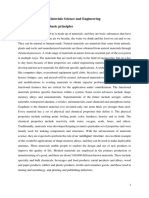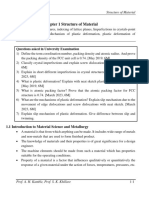Chapt 01
Chapt 01
Uploaded by
Yoon Mo JangCopyright:
Available Formats
Chapt 01
Chapt 01
Uploaded by
Yoon Mo JangCopyright
Available Formats
Share this document
Did you find this document useful?
Is this content inappropriate?
Copyright:
Available Formats
Chapt 01
Chapt 01
Uploaded by
Yoon Mo JangCopyright:
Available Formats
SOLUTIONS MANUAL TO ACCOMPANY
FOUNDATIONS OF MATERIALS SCIENCE AND ENGINEERING
Third Edition
WILLIAM F. SMITH
Professor Emeritus of Engineering University of Central Florida with the collaboration of Javad Hashemi, Ph. D. Associate Professor, Texas Tech University
McGraw-Hill, Inc. New York St. Louis San Francisco Auckland Bogot Caracas Lisbon London Madrid Mexico Milan Montreal New Delhi Paris San Juan Singapore Sydney Tokyo Toronto
FOUNDATIONS OF
MATERIALS SCIENCE AND ENGINEERING
THIRD EDITION WILLIAM F. SMITH
Professor Emeritus of Engineering University of Central Florida with the collaboration of Javad Hashemi, Ph. D. Associate Professor, Texas Tech University Copyright 2004 by McGraw-Hill, Inc.
CHAPTER 1 INTRODUCTION TO MATERIALS SCIENCE AND ENGINEERING
1.1
What are materials? List eight commonly encountered engineering materials. Materials are substances of which something is composed or made. Steels, aluminum alloys, concrete, wood, glass, plastics, ceramics and electronic materials.
1.2
Define materials science and materials engineering. Materials science is the subject which is concerned with basic knowledge of the internal structure, properties, and processing of materials. Materials engineering is the subject which is concerned with the use of fundamental and applied knowledge of materials so that materials can be converted into the products necessary to and desired by society.
1.3
What are the main classes of engineering materials? Metallic, polymeric, ceramic, composite, and electronic materials are the five main classes.
1.4
What are some of the important properties of each of these engineering materials?
Smith
Foundations of Materials Science and Engineering Solution Manual
Metallic Materials many are relatively strong and ductile at room temperature some have good strength at high temperature most have relatively high electrical and thermal conductivities Polymeric Materials generally are poor electrical and thermal conductors most have low to medium strengths most have low densities most are relatively easy to process into final shape some are transparent Ceramic Materials generally have high hardness and are mechanically brittle some have useful high temperature strength most have poor electrical and thermal conductivities Composite Materials have a wide range of strength from low to very high some have very high strength-to-weight ratios (e.g. carbon-fiber epoxy materials) some have medium strength and are able to be cast or formed into a variety of shapes (e.g. fiberglass-polyester materials) some have useable strengths at very low cost (e.g. wood and concrete) Electronic Materials able to detect, amplify and transmit electrical signals in a complex manner are light weight, compact and energy efficient 1.5 Define a composite material. Give an example of a composite material. A composite material is a materials system composed of a mixture or combination of two or more materials. Two examples are carbon-fiber epoxy and fiberglass polyester materials. 1.6 List some materials usage changes which you have observed over a period of time in some manufactured products. What reasons can you give for the changes that have occurred? The modern automobile is being constructed with more and more plastic materials and less metallic due to the lower cost and weight of plastics. 2
Smith
Foundations of Materials Science and Engineering Solution Manual
The modern airplane is using more composite materials and plastics and less metallic materials to reduce plane weight. Modern electronics equipment uses a great number of solid state devices made with electronic materials. These materials are more compact, weigh less, and provide higher overall and energy efficiency. In many cases, they are the only type of material that can be used for specific applications such as complex computer memories. 1.7 What factors might cause materials usage predictions to be incorrect? If a war breaks out and, as a consequence, a raw materials supply is cut off. For example, if a major war broke out in the Middle East, the price of oil would increase, and hence the price of plastic materials would also increase. If a major new discovery is made, some materials usage may change. If defects show up in a specific material after a certain length of its service, the materials usage may decrease. For example, a high strength composite material used for aircraft may start showing some delamination defects.
Smith
Foundations of Materials Science and Engineering Solution Manual
You might also like
- Foundations of Materials Science and Engineering Chap01 SolutionsDocument8 pagesFoundations of Materials Science and Engineering Chap01 Solutionswtss123100% (4)
- Mec 224 Properties of Mat TheoryDocument73 pagesMec 224 Properties of Mat TheoryNoreliana Md Sharif100% (5)
- Foundations of Materials Science and Engineering 4/e: Problems and Solutions To Smith/HashemiDocument6 pagesFoundations of Materials Science and Engineering 4/e: Problems and Solutions To Smith/HashemiSugih Al-Fatih NugrahaNo ratings yet
- Get 226 Lecture NoteDocument20 pagesGet 226 Lecture NoteRaphael GodfreyNo ratings yet
- Chapter 1 Indtoduction of Material ScienceDocument28 pagesChapter 1 Indtoduction of Material ScienceAziziell PDracingNo ratings yet
- Introduction To Material ScienceDocument8 pagesIntroduction To Material Sciencemariakoc69No ratings yet
- Materials Science/ EngineeringDocument3 pagesMaterials Science/ Engineeringnisah123100% (2)
- Structure of Materials Properties of Materials Processing of Materials Performance of MaterialsDocument5 pagesStructure of Materials Properties of Materials Processing of Materials Performance of MaterialsLazat M Hesnbakri100% (1)
- Materials Science and Aerospace MaterialsDocument169 pagesMaterials Science and Aerospace Materialssheikhtihan44No ratings yet
- Unit 5 Engineering MaterialsDocument49 pagesUnit 5 Engineering Materialsvovefoj582No ratings yet
- Introduction To Materials Science & EngineeringDocument30 pagesIntroduction To Materials Science & Engineering2zvhqpfxy2No ratings yet
- INTRO 2 Materials For Engineering - Properties, Repoertoires and SelectionsDocument38 pagesINTRO 2 Materials For Engineering - Properties, Repoertoires and SelectionsTlotlo MmutleNo ratings yet
- Design and Materials SelectionDocument21 pagesDesign and Materials SelectionMusa HussamNo ratings yet
- Workshop No.1 CHE-MATDocument4 pagesWorkshop No.1 CHE-MATs2023101938No ratings yet
- Unit 5.1. Engg. Materials Intro & Classification - 2019Document11 pagesUnit 5.1. Engg. Materials Intro & Classification - 2019Swayam Tejas PadhyNo ratings yet
- Chapter 1 - Introduction To Materials Science and EngineeringDocument6 pagesChapter 1 - Introduction To Materials Science and Engineeringaldz5No ratings yet
- 2 An Introduction To Electronic and Ionic MaterialsDocument4 pages2 An Introduction To Electronic and Ionic MaterialsNaveen KumarNo ratings yet
- Lec 1Document14 pagesLec 1أمير حامدNo ratings yet
- MaterialsDocument71 pagesMaterialsMarzena Madej100% (1)
- Introduction To Engineering Materials (Lecture-01)Document16 pagesIntroduction To Engineering Materials (Lecture-01)AsadNo ratings yet
- Bonga University: Engineering Material (Meng2091)Document19 pagesBonga University: Engineering Material (Meng2091)Mul'isaa Jireenyaa100% (1)
- (Stone Age, Bronze Age, and Iron Age) : Design, Production, and Utilization of MaterialsDocument8 pages(Stone Age, Bronze Age, and Iron Age) : Design, Production, and Utilization of Materialsرائد عبد العزيز فرحانNo ratings yet
- Modern Engineering MaterialsDocument15 pagesModern Engineering MaterialsKarthik PallavaliNo ratings yet
- MMEE 210 - Lecture 02 - MaterialsDocument34 pagesMMEE 210 - Lecture 02 - MaterialsSbonganjaloNo ratings yet
- Chapter 1 A - Crystal StrucutreDocument65 pagesChapter 1 A - Crystal StrucutreAbhishek GramopadhyeNo ratings yet
- Materials Science and EngineeringDocument15 pagesMaterials Science and EngineeringCharlenne CosejoNo ratings yet
- Mamun Sir c3 by AsifDocument7 pagesMamun Sir c3 by Asiflishiya801No ratings yet
- BBC - GCSE Bitesize - MaterialsDocument9 pagesBBC - GCSE Bitesize - MaterialsPathan ShamsheerkhanNo ratings yet
- UNIT 3 Bhs Inggris Teknik Mesin UnimedDocument19 pagesUNIT 3 Bhs Inggris Teknik Mesin Unimedsusmi pitriani hutapeaNo ratings yet
- Water BillDocument42 pagesWater BillkamalibrahimmuazzamNo ratings yet
- Capili Jefferson 1Document6 pagesCapili Jefferson 1Christian Al EncarnacionNo ratings yet
- Lecture 1Document42 pagesLecture 1ayebale samNo ratings yet
- Experiment 1Document6 pagesExperiment 1Jagathisswary SatthiNo ratings yet
- Material Science & Engineering Topic1 NotesDocument10 pagesMaterial Science & Engineering Topic1 Notesyiye rubyNo ratings yet
- Materials Science CHAPTER 1Document5 pagesMaterials Science CHAPTER 1KTINE08No ratings yet
- Material Science - Properties of MaterialsDocument13 pagesMaterial Science - Properties of MaterialsBlessings James Bwalya100% (1)
- MaterialogyDocument181 pagesMaterialogyrajraj3550No ratings yet
- Chapter-1 Funad. Eng MaterialDocument47 pagesChapter-1 Funad. Eng Materialtazeb AbebeNo ratings yet
- Research Proposal For Materials ScienceDocument9 pagesResearch Proposal For Materials SciencePhysics AlertNo ratings yet
- MSE 451 Composite Materials First Part (. Giks's Conflicted Copy 2016-09-19)Document113 pagesMSE 451 Composite Materials First Part (. Giks's Conflicted Copy 2016-09-19)maxwellNo ratings yet
- Introduction-History of Materials As Used in Building Construction, Material Properties and Its ApplicationDocument4 pagesIntroduction-History of Materials As Used in Building Construction, Material Properties and Its ApplicationJobert BautistaNo ratings yet
- Materials Science: Notable EncyclopedicDocument13 pagesMaterials Science: Notable EncyclopedicMadhu DasariNo ratings yet
- Introduction To Smart MaterialsDocument47 pagesIntroduction To Smart MaterialsRajat AgrawalNo ratings yet
- Mohan Maheshwari Assistant Professor-II & Head Department of Mechanical Engineering, Institute of Engineering & Technology, MUDocument36 pagesMohan Maheshwari Assistant Professor-II & Head Department of Mechanical Engineering, Institute of Engineering & Technology, MUMohan MaheshwarINo ratings yet
- Mohan Maheshwari Assistant Professor-II & Head Department of Mechanical Engineering, Institute of Engineering & Technology, MUDocument36 pagesMohan Maheshwari Assistant Professor-II & Head Department of Mechanical Engineering, Institute of Engineering & Technology, MUMohan MaheshwarINo ratings yet
- Me 323-A1m - Tade0, Clarisse F.Document11 pagesMe 323-A1m - Tade0, Clarisse F.Tadeo, Clarisse F.No ratings yet
- EEEE3109-LECTURE-01-2023-2024Document12 pagesEEEE3109-LECTURE-01-2023-2024ctenedefomadeNo ratings yet
- CBR Material TeknikDocument11 pagesCBR Material TeknikTV SHOWNo ratings yet
- Studies On Mechanical and Flexural Strength of Carbon Nano Tube Reinforced With Hemp Vinyl Ester Carbon Fiber Laminated Hybrid Composite-IJRASETDocument12 pagesStudies On Mechanical and Flexural Strength of Carbon Nano Tube Reinforced With Hemp Vinyl Ester Carbon Fiber Laminated Hybrid Composite-IJRASETIJRASETPublications100% (1)
- Classification of Material TypesDocument6 pagesClassification of Material TypesMohamedNo ratings yet
- Engineering Materials & Conc. TechDocument236 pagesEngineering Materials & Conc. Techsusanninsiima233No ratings yet
- Lesson 1 - Types of Engineering MaterialsDocument5 pagesLesson 1 - Types of Engineering MaterialsOwen GichangiNo ratings yet
- Materials Science and Engineering by Callister Chapter 1 ReviewerDocument3 pagesMaterials Science and Engineering by Callister Chapter 1 ReviewerTy ztickNo ratings yet
- Mahmoud Ahmed Hamid Al-Hanafi Ahmed DwidarDocument10 pagesMahmoud Ahmed Hamid Al-Hanafi Ahmed DwidarMostafa GameingNo ratings yet
- Polymers for Electricity and Electronics: Materials, Properties, and ApplicationsFrom EverandPolymers for Electricity and Electronics: Materials, Properties, and ApplicationsNo ratings yet



























































